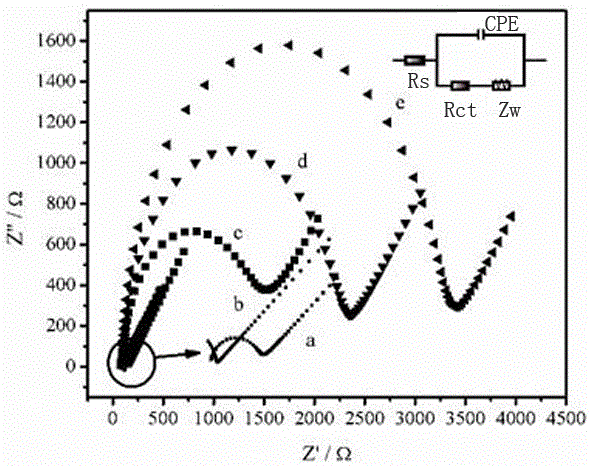Electrochemiluminescent biosensor for detection of endonuclease, preparation and application thereof
A luminescent bio-electrochemical technology, applied in the direction of chemiluminescence/bioluminescence, electrochemical variables of materials, and analysis by making materials undergo chemical reactions, can solve the problems of high price, complicated detection equipment and processing process, and achieve high Specificity, rapid and accurate detection, and good stability
- Summary
- Abstract
- Description
- Claims
- Application Information
AI Technical Summary
Problems solved by technology
Method used
Image
Examples
Embodiment 1
[0047] A method for preparing an electrochemiluminescent biosensor for detecting endonuclease EcoRI, comprising the following steps:
[0048] (1) Glassy carbon electrode pretreatment: Glassy carbon electrode is treated with 0.05μm α-A1 2 o 3 After the polishing powder is polished, it is rinsed with deionized water, and ultrasonicated in deionized water and ethanol for 10 min respectively. Using a three-electrode system for detection, the working electrode is a glassy carbon electrode, the counter electrode is a platinum wire electrode, and the reference electrode is an Ag / AgCl electrode. In 0.5M sulfuric acid, set the voltage at -0.2 to 1.6V to cycle the glassy carbon electrode. Voltammetric scanning, after the detection, rinse the electrode with deionized water, dry the surface of the electrode, and set aside.
[0049] (2) Preparation of gold nano-graphene modified glassy carbon electrode: at 0.5mgmL -1 In the mixture of graphite oxide (GO) and 20mM chloroauric acid, cycli...
Embodiment 2
[0067] A method for preparing an electrochemiluminescent biosensor for detecting endonuclease EcoRI, comprising the following steps:
[0068] (1) Glassy carbon electrode pretreatment: Glassy carbon electrode is treated with 0.3μm α-A1 2 o 3 After the polishing powder is polished, it is rinsed with deionized water, and ultrasonicated in deionized water and ethanol for 10 min respectively. Using a three-electrode system for detection, the working electrode is a glassy carbon electrode, the counter electrode is a platinum wire electrode, and the reference electrode is an Ag / AgCl electrode. In 0.5M sulfuric acid, set the voltage at -0.2 to 1.6V to cycle the glassy carbon electrode. Voltammetric scanning, after the detection, rinse the electrode with deionized water, dry the surface of the electrode, and set aside.
[0069] (2) Preparation of gold nano-graphene modified glassy carbon electrode: at 1mgmL -1 In the mixture of graphite oxide and 60mM chloroauric acid, cyclic voltam...
Embodiment 3
[0083] A method for preparing an electrochemiluminescent biosensor for detecting endonuclease ApaI, comprising the following steps:
[0084] (1) Glassy carbon electrode pretreatment: Glassy carbon electrode is treated with 0.3μm α-A1 2 o 3 After the polishing powder is polished, it is rinsed with deionized water, and ultrasonicated in deionized water and ethanol for 10 min respectively. Using a three-electrode system for detection, the working electrode is a glassy carbon electrode, the counter electrode is a platinum wire electrode, and the reference electrode is an Ag / AgCl electrode. In 0.5M sulfuric acid, set the voltage at -0.2 to 1.6V to cycle the glassy carbon electrode. Voltammetric scanning, after the detection, rinse the electrode with deionized water, dry the surface of the electrode, and set aside.
[0085] (2) Preparation of gold nano-graphene modified glassy carbon electrode: at 1mgmL -1 In the mixture of graphite oxide and 60mM chloroauric acid, cyclic voltamm...
PUM
 Login to View More
Login to View More Abstract
Description
Claims
Application Information
 Login to View More
Login to View More - R&D Engineer
- R&D Manager
- IP Professional
- Industry Leading Data Capabilities
- Powerful AI technology
- Patent DNA Extraction
Browse by: Latest US Patents, China's latest patents, Technical Efficacy Thesaurus, Application Domain, Technology Topic, Popular Technical Reports.
© 2024 PatSnap. All rights reserved.Legal|Privacy policy|Modern Slavery Act Transparency Statement|Sitemap|About US| Contact US: help@patsnap.com










